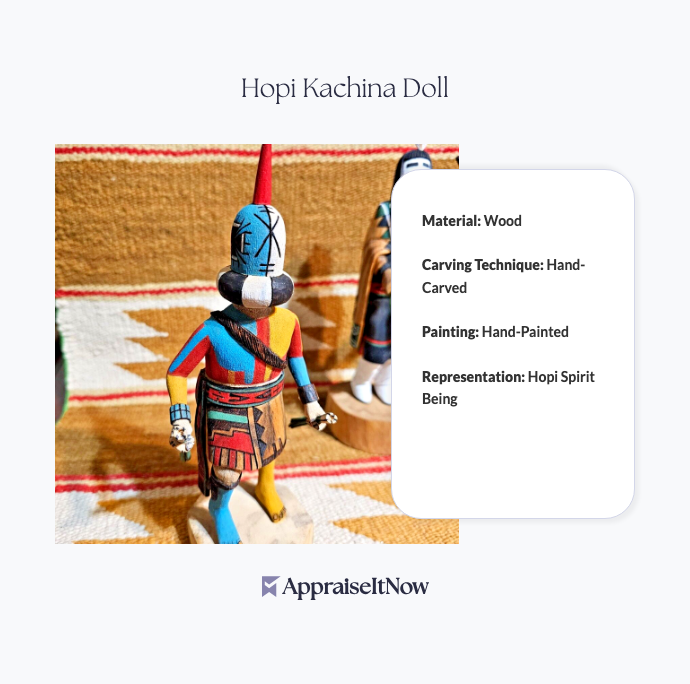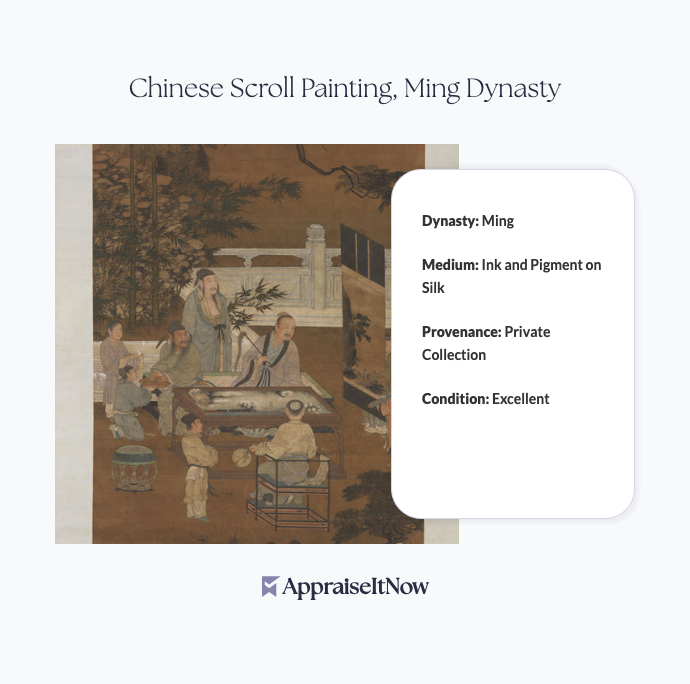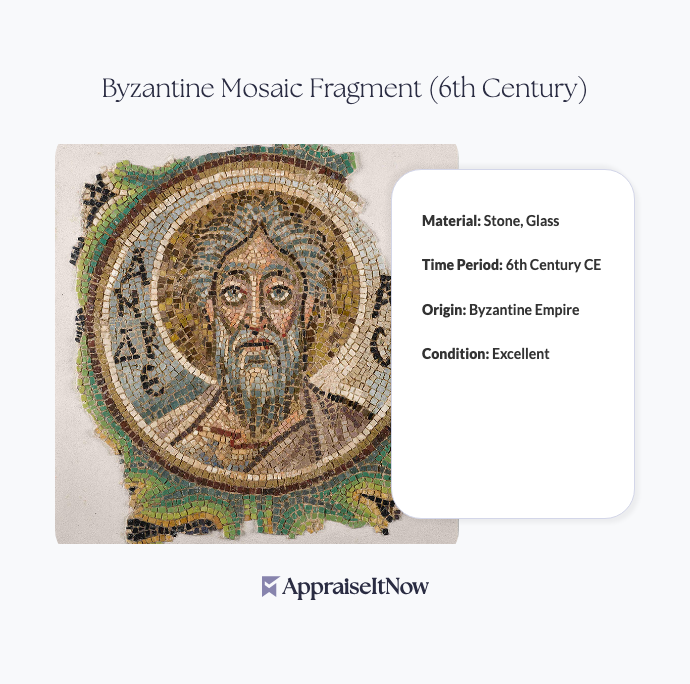<h1>How to Get Your Hopi Kachina Doll Appraised</h1>
<p>Hopi Kachina dolls represent far more than decorative objects—they embody centuries of Native American spiritual tradition and artistic mastery. If you own one of these culturally significant pieces and need to understand its value for insurance, sale, or estate planning purposes, obtaining a professional appraisal is essential. These handcrafted dolls typically command values between <strong>$800 and $1,500</strong>, though rare or historically significant examples can exceed these ranges considerably.</p>
<h2>Understanding Hopi Kachina Doll Value Foundations</h2>
<p>Your Hopi Kachina doll's worth depends on multiple interconnected factors that distinguish authentic, valuable pieces from newer reproductions. The dolls represent Hopi spiritual beliefs through intricate carved designs and vibrant natural pigments, making them highly sought after in both the <a href="/types/artwork">art</a> and <a href="/types/memorabilia-and-collectibles">memorabilia and collectibles</a> markets. Collectors and institutions prize these pieces for their unique aesthetic appeal and the deeper cultural significance behind each character representation.</p>
<p>The history of Kachina dolls extends back to the 15th century, though their evolution as collectible art accelerated during the 20th century. Understanding this timeline helps contextualize your doll's production era, which significantly affects its appraised value. First-generation carved examples from the mid-1900s command different prices than contemporary pieces, much like how <a href="/types/antique-artwork">antique artwork</a> valuations reflect historical periods.</p>
<h2>Key Factors That Determine Your Doll's Value</h2>
<p>When a professional appraiser evaluates your Hopi Kachina doll, they examine several critical characteristics. <strong>Material composition</strong> stands paramount—authentic Kachinas are carved from cottonwood root, a lightweight wood native to the Southwest. The quality of carving reveals the artisan's skill level, with intricate details and balanced proportions commanding premium prices.</p>
<p>The <strong>pigments and paint application</strong> also significantly impact value. Traditional Kachinas utilized natural pigments derived from minerals and plants, creating distinctive color palettes that differ markedly from synthetic paints. Appraisers look for evidence of aging consistency and application techniques that match historical practices. A doll painted with contemporary acrylic paints, regardless of artistic merit, typically appraises lower than one maintaining original natural pigment work.</p>
<p><strong>Village origin and rarity</strong> constitute another crucial valuation element. Each Hopi village maintains distinct carving styles and character representations, with some villages producing more collectible variations than others. Your doll's documentation indicating which village produced it—or which family lineage created it—adds substantial value, particularly if passed down through generations as originally intended within Hopi tradition.</p>
<div class="callout tip"><p><strong>Collector's Insight</strong></p>
<p>Kachinas with documented family histories or clear evidence of ceremonial use command 20-30% premiums over undocumented examples, similar to how <a href="/types/sports-memorabilia">sports memorabilia</a> valuations increase with authenticated provenance.</p></div>
<h2>Authenticity: The Critical Distinction</h2>
<p>Determining whether your Kachina doll is authentically Hopi-carved versus a contemporary reproduction requires expert analysis. Authentic pieces display specific wear patterns, tool marks, and finishing techniques that distinguish them from newer versions. Professional appraisers trained in <a href="/blog/appraising-ethnographic-artifacts-evaluating-cultural-heritage-for-institutions">ethnographic artifacts</a> can identify these markers through careful physical examination.</p>
<p>The question of whether it's acceptable to purchase Kachina dolls involves cultural and legal considerations that impact value. Some Hopi community members maintain that these sacred objects shouldn't be commercialized outside tribal contexts, though the market for collectible examples remains active. Understanding these perspectives helps frame your doll's position within the broader collecting community and affects how appraisers position valuations relative to cultural significance.</p>
<p>Reproductions carved by non-Hopi artisans or mass-produced examples typically appraise at <strong>$50-$200</strong>, creating a dramatic distinction from authentic Hopi-carved pieces at $800-$1,500. Learning to identify these differences protects both your investment and demonstrates respect for cultural origins. Professional appraisers provide this authentication service, offering detailed documentation of your doll's characteristics and estimated age.</p>
<h2>Condition and Preservation Considerations</h2>
<p>Your Kachina doll's physical condition directly affects its appraisal value, much like condition impacts assessments of <a href="/types/antique-furniture">antique furniture</a> and other collectibles. Collectors distinguish between dolls showing appropriate aging patina—minor surface wear consistent with age and respectful handling—versus those exhibiting damage, repairs, or restoration work.</p>
<p>Cracks in the wood, paint loss, or previous restoration attempts typically reduce values by 15-40%, depending on severity and repair quality. However, a well-maintained original doll with intact paint and minimal wear can achieve valuations at the upper end of the range. Environmental factors matter significantly; dolls stored in stable, climate-controlled conditions maintain their integrity far better than those exposed to temperature fluctuations or excessive humidity.</p>
<p>When assessing whether your doll requires conservation, consult professionals experienced with <a href="/blog/evaluating-cultural-heritage-appraisals-of-indigenous-art-and-artifacts">cultural heritage preservation</a>. Inappropriate restoration can diminish value, whereas professional conservation often enhances both aesthetic appeal and market positioning. This parallels how restoring <a href="/types/antique-jewelry">antique jewelry</a> requires specialized expertise to maintain or increase value.</p>
<h2>Distinguishing Hopi from Navajo and Other Tribal Variations</h2>
<p>Understanding regional differences helps contextualize your doll's specific value proposition. While Navajo artisans create their own kachina figures, the distinctions significantly affect appraisal values. Hopi Kachinas originate from specific Hopi villages and represent characters integral to Hopi ceremonial cycles, whereas Navajo kachinas, though inspired by Hopi traditions, follow different artistic conventions and carry distinct cultural meanings.</p>
<p>Pueblo peoples from other New Mexico communities also carve kachina-inspired figures, each representing unique artistic traditions. These distinctions matter profoundly to collectors and appraisers who understand tribal-specific characteristics. Your appraisal documentation should clearly identify your doll's cultural origin, providing collectors with confidence in their purchase decisions.</p>
<p>The spiritual significance of Hopi Kachina dolls—representing spirit beings and supernatural entities essential to Hopi religious practices—means authentic pieces carry cultural weight beyond their monetary value. Professional appraisers trained in <a href="/blog/evaluating-cultural-heritage-appraisals-of-indigenous-art-and-artifacts">indigenous art and cultural heritage</a> appreciate this context and reflect it appropriately in valuations and documentation.</p>
<h2>Current Market Dynamics and Collector Interest</h2>
<p>The collectible Kachina doll market demonstrates steady demand from serious collectors, institutions, and cultural enthusiasts. Art markets show consistent interest in authentic Native American pieces, with tribal-specific examples commanding particular attention. Your doll's market value reflects both its intrinsic artistic and cultural qualities and the broader collector demand for authentic Southwestern art.</p>
<p>Several factors influence contemporary Kachina valuations. Increased awareness of cultural appropriation has actually strengthened markets for authentically produced tribal art, as collectors seek genuine pieces created by tribal artisans. Educational initiatives about Hopi traditions have expanded collector knowledge, enabling more informed purchasing decisions. This means well-documented, authentically-produced Kachinas with clear provenance typically appreciate over time.</p>
<div class="callout note"><p><strong>Market Insight</strong></p>
<p>Authenticated Hopi Kachinas continue attracting collector interest globally, with pieces appearing regularly in specialized auctions and gallery exhibitions alongside other <a href="/blog/unveiling-the-world-of-tribal-art-appraising-masks-sculptures-and-textiles">tribal art</a> categories.</p></div>
<h2>When to Seek Professional Appraisal Services</h2>
<p>You should obtain a professional Kachina doll appraisal in several specific circumstances. If you're planning to sell, an independent valuation provides market-based documentation supporting your asking price. For insurance purposes, a certified appraisal ensures you have adequate coverage reflecting the doll's current value and replacement cost.</p>
<p>Estate planning situations require documented valuations for fair distribution among beneficiaries or for tax purposes. If you're considering a donation to cultural institutions or museums, a professional appraisal supports tax deduction claims and demonstrates your commitment to proper stewardship. Legal disputes involving ownership or value also necessitate independent, professionally-documented assessments.</p>
<p>The appraisal process itself involves detailed photographic documentation, condition assessment, research into comparable recent sales, and expert analysis of your doll's specific characteristics. Professional appraisers provide USPAP-compliant reports accepted by insurance companies, financial institutions, and legal proceedings. This documentation protects your interests whether you're buying, selling, insuring, or planning estate distribution.</p>
<p>AppraiseItNow connects you with credentialed appraisers experienced in <a href="/blog/appraising-artifacts-and-antiquities-evaluating-historical-finds">cultural heritage and indigenous art</a> valuations. Our network includes experts certified through organizations like the American Society of Appraisers (ASA), ensuring professional standards and accurate market-based valuations for your Hopi Kachina doll.</p>
<h2>Documenting Your Doll's Provenance</h2>
<p>Building a comprehensive documentation file strengthens your doll's market position and appraisal value. If you inherited your Kachina, gather any available family records indicating acquisition date, origin village, or previous owner information. Photographs from different angles, detailed images of carving details, and documentation of any visible maker's marks all enhance your appraisal file.</p>
<p>Original receipt or purchase documentation, if available, provides valuable provenance evidence. Family histories explaining how and where the doll was acquired add contextual value. Even incomplete information helps appraisers establish reasonable estimates and creates market confidence for future buyers or institutions.</p>
<p>Professional appraisers add substantial value to this documentation process by conducting archival research, consulting market databases, and providing expert interpretation of your doll's characteristics. Their formal reports become the authoritative reference document, replacing informal family knowledge with professionally-substantiated valuations suitable for legal, financial, or commercial purposes.</p>
<hr />
<div class="callout note"><p><strong>Key Takeaway</strong></p>
<p>Your Hopi Kachina doll represents a significant cultural and artistic asset typically valued between $800 and $1,500. Professional appraisal documentation ensures accurate valuation, proper authentication, and the confidence you need whether you're buying, selling, insuring, or preserving this authentic piece of Native American heritage for future generations.</p></div>







.avif)







